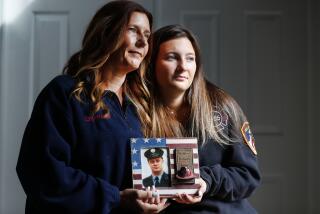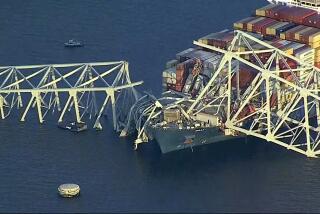N.Y. Crash Victims’ Kin Still Seek a Place of Remembrance
NEW YORK — It is New York’s other memorial, overshadowed by the process of remembering the victims of the World Trade Center attack.
Only a small plaque on the sidewalk, a few plastic leaves from an old flower arrangement and several tiny real plants mark the place where American Airlines Flight 587 plunged through fog into a street in the Rockaway area of Queens.
The crash on Nov. 12, 2001 -- two months and a day after the twin towers collapsed -- killed 265 people in one of the nation’s worst aviation accidents. Many of those aboard the flight from John. F. Kennedy International Airport to the Dominican Republic were immigrants or relatives of Dominicans who had settled in Washington Heights in upper Manhattan.
Plans for a permanent memorial have hit obstacles as families of the victims, residents of the Belle Harbor section of Rockaway and the Bloomberg administration have been unable to agree on a site and a design.
Many in who live in the neighborhood where the plane came down argue that the memorial should not be at the crash site. Relatives of those who died are frustrated it is taking so long for a fitting memorial to take shape. The city is trying to find a plan that will satisfy both groups.
Rebuilding is well underway in the community alongside the Atlantic Ocean where the plane’s wings and other parts plowed into homes, killing those aboard and five people on the ground. But memories remain fresh.
“The debris and the bodies were all over the place,” said Margaret McGowan as she removed leaves recently from her front lawn. “We are lucky we’re still here.”
She pointed down the block to where a woman perished while making breakfast in a kitchen and whose husband was killed in another room.
Rockaway is home to scores of families of police officers and firefighters. The tightknit community was hard-hit on Sept. 11, losing more than 70 people.
Some say there has been enough grief, and a permanent memorial to Flight 587 should be erected somewhere other than the street where the Airbus crashed.
“Not here. It’s a residential area,” said McGowan.
Families who lost relatives in the crash said they appreciated the neighborhood’s suffering, but their grief also remained fresh and deserved to be recognized.
“We don’t want to be forgotten,” said Fernando Mateo, president of Hispanics Across America, a nonprofit organization that advocates for Latinos in communities across the U.S.
“To me, every day is getting up and living the same nightmare over and over again,” said Hector Algarroba, a project manager for an air-conditioning company whose parents were killed in the crash.
“We have been trying to honor the dignity, respect and beautiful memories left behind by the 265 loved ones,” he said. “We are working to have a permanent memorial. It has been a long process, and we will continue to work to see that the right decision be taken.”
On the first anniversary of the crash, Mayor Michael R. Bloomberg said the tragedy had resulted in a “bridge of compassion” being built between New York’s Dominican Americans and the people of Belle Harbor.
But as time has passed, some family members fear the bridge is weakening.
The mayor has continued to say the victims “deserve a fitting memorial in Rockaway,” and he traveled to Bani in the Dominican Republic to visit a monument in a town many of the passengers came from.
“I have to be honest and give credit where credit is due,” said Mateo, who represents about two dozen of the families. “He is trying to find a solution.”
This month, he conferred with members of Bloomberg’s staff and emerged optimistic after the meeting at City Hall, during which a number of sites were discussed. Although the families prefer Beach 131st Street and Newport Avenue, where the plane hit, the most likely site is a park about a mile away with a view of the ocean.
It is close to public transportation and represents a compromise with Belle Harbor residents opposed to groups regularly visiting the crash site, where homes are being rebuilt.
“The mayor has said he liked the site in the Dominican Republic, and it could be duplicated in the park,” Mateo said.
Scholars who have studied memorials said the problem of achieving consensus among families caught up in mass tragedy was not unique.
“You expect infighting over aesthetic differences -- what should be and shouldn’t be, what it should look like, feel like, who should pay for it and how do you dedicate it,” said Janet Walton, professor of worship at the Union Theological Seminary in New York. “It is part of the grieving process.”
“The process of creating memorials is a complicated act that brings up physical issues, social issues and psychological issues,” she added.
Some experts say the speed with which events are recorded and then fade from public view exerts pressure to build memorials rapidly before tragedies are forgotten.
“We live in a fast-paced culture, a culture that is so inimical to memory that if you don’t mark an event in stone somewhere, we are afraid as a community it is going to be gone,” said Miroslav Volf, a theology professor at Yale University’s Divinity School and director of the university’s Center for Faith and Culture.
“Hence, we tend to memorialize quickly. This can have the consequence of not having sufficient time passing and being distant enough for our memories to mature,” he said.
Mateo believes more than enough time has passed.
“The victims of Flight 587 are in the shadows of 9/11,” he said. “I think the mayor gave us ample time to work with the administration. You are not going to please everybody. We need to make a decision. The bottom line is we need a memorial and the families need to have a place to go to worship, and those who don’t want to go, won’t go.”
More to Read
Sign up for Essential California
The most important California stories and recommendations in your inbox every morning.
You may occasionally receive promotional content from the Los Angeles Times.










